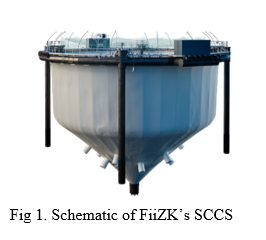SEMI-CLOSED CONTAINMENT SYSTEMS FOR FINFISH AQUACULTURE: ASSESSING MULTIPLE PARAMETERS FROM A COMMERCIAL SCALE OPERATON
Semi-closed Containment Systems (SCCS), where an impermeable bag or structure separates farmed fish from the external marine environment, are gaining traction as a viable farming production system of salmonids. Early trials of enclosed floating aquaculture systems occurred from the early 1990s using a 450 m3 PVC bag. Since then, through development and optimisation phases, we now see this technology being upscaled to commercial level productions with systems utilising 30,000 m3 bags.
The main aim of adopting these systems is to limit or exclude challenges that impact fish welfare and the environment recognised in traditional open-net farming such as sea lice, predator interactions, fish escapes and waste capture. FiiZK is a producer of SCCS (Fig. 1) where we have developed a system that closes the production volume using a PVC bag and monitors the cage environment through a sensor network.
In this particular case, we provide welfare, sea lice, mortality and water quality data from a commercial scale production, where two-hundred thousand fish were stocked in six Certus 15000 SCCS in 2021, to highlight the potential these systems have for growing post-smolt from 100g to 2kg.
Welfare on 20 fish from each of the SCCS was assessed weekly by trained staff using morphological Operational Welfare Indicator’s and results ranged from 0.01 to 0.87, where 0 is little or no evidence of this OWI and 1 is minor evidence of this OWI. Sea lice counts were carried out weekly and average scores showed that the number of lice ranged from zero lice to 0.13 and no sea lice treatments were carried out over the 7-month cycle. Accumulated mortality in the enclosures was between 0.6% and 3.9%. In one enclosure, elevated mortality was recorded because of wounds that occurred from handling and transferring fish from the open-net pens into the SCCS. This progressed into an acute secondary bacterial infection in the SCCS. Water quality remained within ranges that are acceptable for growing Atlantic Salmon and was highly correlated with seasonal variation in the fjord.
